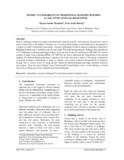Please use this identifier to cite or link to this item:
https://elibrary.khec.edu.np:8080/handle/123456789/147Full metadata record
| DC Field | Value | Language |
|---|---|---|
| dc.contributor.author | Basukala, Shyam Sundar | - |
| dc.contributor.author | Maskey, Prem Nath | - |
| dc.date.accessioned | 2022-04-28T12:21:30Z | - |
| dc.date.available | 2022-04-28T12:21:30Z | - |
| dc.date.issued | 2017-04 | - |
| dc.identifier.issn | 2091—1475 | - |
| dc.identifier.uri | https://elibrary.khec.edu.np/handle/123456789/147 | - |
| dc.description.abstract | Historic buildings of Nepal are mainly constructed from masonry structure. Since masonry structures are weak in tension which leads to the failure of structure. So, to avoid possible damage in environment lives and property it is urgent to conduct vulnerability assessments. Seismic vulnerability of historic masonry buildings constructed in Bhaktapur at Byasi area is carried out for the case study. Five load bearing masonry buildings were selected out of 147 buildings considering opening percentage, storey and type of floor for modeling in SAP 2000 V10 Various methods of rapid visual screening (FEMA 154, EMS 98) are used to determine the vulnerability of the selected building. The Selected Building response is carried out by linear time history analysis. The seismic vulnerability of masonry structures is determined in terms of fragility curves which represent the probability of failure or damage due to various levels of strong ground motions for different damage state slight, moderate, extensive and collapse. From the result of Rapid Visual Screening (RVS) and Fragility curves of the buildings it is found that whole, buildings are found vulnerable from future earthquake. | en_US |
| dc.language.iso | en | en_US |
| dc.subject | Vulnerability, masonry building, RVS, time history analysis, Fragility curves | en_US |
| dc.title | SEISMIC VULNERABILITY OF TRADITIONAL MASONRY BUILDING A CASE STUDY OF BYASI, BHAKTAPUR | en_US |
| Appears in Collections: | Journal of Science and Engineering Vol.4 | |
Files in This Item:
| File | Description | Size | Format | |
|---|---|---|---|---|
| 4_Shyam_Sundar_Basukala.pdf | 1.41 MB | Adobe PDF |  View/Open |
Items in DSpace are protected by copyright, with all rights reserved, unless otherwise indicated.
